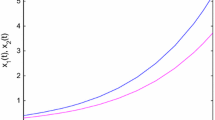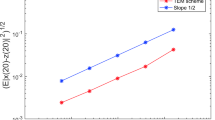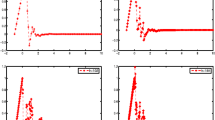Abstract
In this paper, we concern stability of numerical methods applied to stochastic delay integro-differential equations. For linear stochastic delay integro-differential equations, it is shown that the mean-square stability is derived by the split-step backward Euler method without any restriction on step-size, while the Euler–Maruyama method could reproduce the mean-square stability under a step-size constraint. We also confirm the mean-square stability of the split-step backward Euler method for nonlinear stochastic delay integro-differential equations. The numerical experiments further verify the theoretical results.
Similar content being viewed by others
1 Introduction
Stochastic delay integro-differential equations, as the mathematical model, widely apply in biology, physics, economics and finance [1, 2]. Because of the stochastic delay integro-differential equations themselves, it is not easy to obtain an explicit solution for these kinds of equations, so it is necessary to research the numerical methods for numerical solution of stochastic delay integro-differential equations [3, 4]. Stability is the basic and important property of numerical methods for stochastic systems.
There are few results on the numerical methods to stochastic delay integro-differential equations. Ding et al. [5] dealt with the stability of the semi-implicit Euler method for linear stochastic delay integro-differential equations. Rathinasamy and Balachandran [6] proved mean-square stability of the Milstein method for linear stochastic delay integro-differential equations with Markovian switching under suitable conditions on the integral term. The condition under which the split-step backward Euler method was mean-square stable has been obtained by Tan and Wang [7, 8]. Rathinasamy and Balachandran [9] also analyzed T-stability of the split-step-θ-methods for linear stochastic delay integro-differential equations. Wu [10] investigated the mean-square stability for stochastic delay integro-differential equations by the strong balanced methods and the weak balanced methods with sufficiently small step-size. Numerical researches for stochastic delay integro-differential equations are not perfect enough. Therefore, it is extremely essential to develop the stability of the numerical methods to stochastic equations.
The paper is organized as follows. In Sect. 2 we will introduce related symbols and definitions. Some suitable conditions will be given to guarantee stability of the Euler–Maruyama method for stochastic delay integro-differential equations in Sect. 3. In Sect. 4, the split-step backward Euler method will be used to prove general mean-square stability of numerical solutions. In Sect. 5, we will discuss stability of nonlinear stochastic delay integro-differential equations. Furthermore, numerical experiments are provided in Sect. 6.
2 Preliminaries
Throughout this paper, unless otherwise specified, let \((\Omega,\mathcal {F},P)\) be a complete probability space with a filtration \((\mathcal {F}_{t})_{t\geq0}\), which satisfies the usual conditions (i.e., it is increasing and right continuous while \(\mathcal{F}_{0}\) contains all P-null sets). Let \(|\cdot|\) be the Euclidean norm, \(W(t)\) is Wiener process defined on the probability space, which be \(\mathcal {F}_{t}\)-adapted and independent of \(\mathcal{F}_{0}\). Let \(\tau>0\) and \(C([-\tau,0];\mathbb{R})\) denote the family of all continuous \(\mathbb {R}\)-valued functions on \([-\tau,0]\), \(C([-\tau,0];\mathbb{R}^{d})\) denote the family of all continuous functions ξ from \([-\tau,0]\) to \(\mathbb{R}^{d}\), \(\|\xi\|\) is defined by \(\|\xi\|=\sup_{-\tau\leq t\leq 0}|\xi(t)|\). We assume \(\xi(t)\), \(t\in[-\tau,0]\) is the initial function, which is \(\mathcal{F}_{0}\)-measurable and right continuous, \(E\|\xi\| ^{2}<\infty\). Let \(\mathcal{C}_{\mathcal{F}_{0}}^{b}([-\tau,0];\mathbb{R})\) be the family of all \(\mathcal{F}_{0}\)-measurable bounded \(C([-\tau,0];\mathbb {R})\)-valued random variables \(\xi=\{\xi(\theta): -\tau\leq\theta\leq0\}\).
As a matter of convenience, we first consider the following form of linear stochastic delay integro-differential equations:
where \(\xi(t)\) is initial function, and \(\xi(t)\in C([-\tau,0];\mathbb {R})\), \(\alpha, \beta, \gamma, \lambda, \mu, \eta\in\mathbb{R}\), \(W(t)\) is a standard one-dimensional Wiener process and τ is the delay term.
Under the above assumptions, Eq. (1) has a unique solution \(x(t)\). In order to analyze mean-square stability of two numerical methods, we introduce the following lemma [11].
Lemma 2.1
If
the solution of Eq. (1) is said to be mean-square stable, that is,
3 Mean-square stability of the Euler–Maruyama method
Now, the Euler–Maruyama method applied to Eq. (1) one gets
where \(\xi=X_{0}\), \(X_{n}\) is an approximation to the analytical solution \(x(t_{n})\),n which is \(\mathcal{F}_{t_{n}}\)-measurable, \(h>0\) is the given step-size, which satisfies \(h=\frac{\tau}{m}\) for a positive integer m, \(t_{n}=nh\), \(n=-m,\ldots,0\), and we get \(X_{n}=\xi (t_{n})\) when \(t_{n}\leq0\), \(\triangle W_{n}=W(t_{n+1})-W(t_{n})\) are independent \(N(0,h)\) distributed stochastic variables. \(\bar{X_{n}}\) approaches the integral term, this paper will choose a composite trapezoidal rule as the tool of the disperse integral to solve this case. We have
Definition 3.1
If there exists a \(h_{0}>0\), for every step-size \(h\in(0,h_{0}]\) with \(h=\frac{\tau}{m}\), such that the numerical approximation \(\{X_{n}\}\) produced by the Euler–Maruyama method satisfies
then the numerical method applied to Eq. (1) is said to be mean-square stable.
Theorem 3.1
Under the condition (2), let \(h_{0}=\max\{h_{1},h_{2}\}\), for step-size \(h\in (0,h_{0}]\), we have
then the Euler–Maruyama method applied to Eq. (1) is mean-square stable, where
Proof
From Eq. (4), we obtain
Squaring both sides of Eq. (6), we have
It follows from \(2ab\leq|ab|(x^{2}+y^{2})\), where \(a,b\in\mathbb{R}\), \(\tau =mh\), that
According to the inequality \((a_{1}+a_{2}+\cdots+a_{n})^{2}\leq n(a_{1}^{2}+a_{2}^{2}+\cdots+a_{n}^{2})\),
In a similar way
We note that \(E(\triangle W_{n})=0\), \(E[(\triangle W_{n})^{2}]=h\), and \(X_{n}, X_{n-1},\ldots,X_{n-m}\) are \(\mathcal{F}_{t_{n}}\)-measurable. Substituting (7), (8), (9) into the above equation and taking expectations,
Let \(Y_{n}=E|X_{n}^{2}|\), we have
where
So
It is clear that \(Y_{n}\rightarrow0\) (\(n\rightarrow\infty\)) if \(P+Q+R<1\), namely
Hence let
By the condition (2), we know that \(h_{1}>0\), \(h_{2}>0\). If \(h_{0}\in(0,h_{1})\), we have
On the other side, we address the case \(1+\alpha h>0\). If \(h_{0}\in(0,h_{2})\), we get
Let \(h_{0}\in\max\{h_{1},h_{2}\}\); when \(h\in(0,h_{0}]\), \(P+Q+R<1\) always holds, then
then the Euler–Maruyama method applied to Eq. (1) is mean-square stable. The theorem is completed. □
4 General mean-square stability of the split-step backward Euler method
Using the split-step backward Euler method applied to Eq. (1), we construct the numerical scheme as follows:
the relevant definitions are in Sect. 3, if \(1-\alpha h\neq0\), we can get the sequences\(\{X_{n}^{\ast},n\geq0\}\) and \(\{X_{n},n\geq1\}\) via (10), when given \(X_{n}=\xi(nh)\) for \(n\in\{-m,-m+1,\ldots,0\}\).
Definition 4.1
For every step-size \(h=\frac{\tau}{m}\), if any application of the split-step backward Euler method to Eq. (1) generates a numerical approximation \(\{X_{n}\}\) that satisfies
then the numerical method applied to Eq. (1) is said to be general mean-square stable.
Theorem 4.1
Under the condition (2), assume \(1-\alpha h\neq0\), the split-step backward Euler method applied to Eq. (1) is generally mean-square stable.
Proof
Assume \(1-\alpha h\neq0\) and implying \(\alpha<0\); we can see from (10) that
Squaring both sides of Eq. (12),
According to \(2abxy\leq|ab|(x^{2}+y^{2})\) and \(E(\triangle W_{n})=0\), \(E[(\triangle W_{n})^{2}]=h\), substituting (7), (8), (9) into the above equation and taking expectations
in particular
where
Let \(Y_{n}=E|X_{n}^{2}|\), the above inequality turns into
We conclude that \(Y_{n}\rightarrow0\) (\(n\rightarrow\infty\)), if \(P+Q+R<1\), that is,
Hence, we have
Let
where
It is easy to see \(A>0\), Because of the nature of a quadratic function, we can see that \(F(h)<0\) holds for any \(0< h<1\), when \(\frac{-B+\sqrt {\triangle}}{2A}\geq1\), and the split-step backward method Euler is general mean-square stable. This proves the theorem. □
5 Mean-square stability of the split-step backward Euler method for nonlinear stochastic systems
In this section, we will discuss the mean-square stability of the split-step backward Euler method for nonlinear stochastic delay integro-differential equations. Considering the following nonlinear stochastic equation:
\(f:\mathbb{R}^{d}\times\mathbb{R}^{d}\times\mathbb{R}^{d}\rightarrow\mathbb {R}^{d}\), \(g:\mathbb{R}^{d}\times\mathbb{R}^{d}\times\mathbb{R}^{d}\rightarrow \mathbb{R}^{d\times m}\), \(\xi(t)\in C([-\tau,0];\mathbb{R}^{d})\), \(W(t)\) is an m-dimensional Wiener process and τ is a delay term. If f and g are sufficiently smooth and satisfy the Lipschitz condition and the linear growth condition, Eq. (13) has a unique strong solution \(x(t)\), \(t\in[-\tau,\infty)\) and \(x(t)\) is a measurable, sample-continuous and \(\mathcal{F}_{t}\) adapted process [12, 13].
The split-step backward Euler method applied to Eq. (13) yields
\(X_{n}\), \(X_{n}^{\ast}\), \(\bar{X}_{n}\), h, \(\triangle W_{n}\) are defined in Sects. 3 and 4.
Lemma 5.1
([14])
If there exist constant \(a_{1}\), \(a_{2}\), \(a_{3}\), \(b_{1}\), \(b_{2}\), \(b_{3}\), for all \(x,u,v\in \mathbb{R}^{d}\), we have
Theorem 5.1
Suppose that Lemma 5.1 holds and let
If there exists a \(h_{0}>0\), for every step-size \(h\in(0,h_{0}]\), we have
Then the numerical solution of Eq. (13) is mean-square stable, where
Proof
From the second equation of (14), we obtain
Note that \(E(\triangle W_{n})=0\), \(E[(\triangle W_{n})^{2}]=h\), and \(X_{n}\), \(X_{n-m}\), X̄ are \(\mathcal{F}_{t_{n}}\)-measurable, hence
Combining condition (17) and taking expectations on both sides of the above equation,
Next, we should derive the \(E|X_{n}^{\ast}|^{2}\) by the first equation of (14),
Squaring both sides of Eq. (19), one gets
Through the conditions (15), (16), we have
It is easily to see that for \(X_{n}^{\ast}\bar{X}_{n}\) from Sect. 3
Substituting these into Eq. (20) and taking expectations
In particular
Hence
We can write
where
So
If \(P+Q+R<1\), it is easily to see that \(E|X_{n}|^{2}\rightarrow0\) when \(n\rightarrow\infty\). By the condition (18), we have
Namely
Therefore, for every step-size \(h\in(0,h_{0}]\), \(\lim_{n\rightarrow\infty }E|X_{n}|^{2}=0\) holds, the split-step backward Euler method for nonlinear stochastic equations is mean-square stable. The proof is complete. □
6 Numerical experiments
In this section, we will discuss the example to verify the theoretical results, considering the following testified equation:
Taking the parameters \(\alpha=-10\), \(\beta=2\), \(\gamma=1\), \(\lambda=0.5\), \(\mu =0.2\), \(\eta=0.5\), the condition (2) is satisfied.
Case 1. We can easily see that \(h_{1}=\frac{12.56}{169}\), \(h_{2}=\min\{\frac {1}{10},\frac{12.56}{49}\}\). By Theorem 3.1, \(h_{0}=\max\{h_{1},h_{2}\}=\frac{1}{10}\). When the step-size \(h\in(0,\frac{1}{10}]\), the Euler–Maruyama method applied to Eq. (21) is mean-square stable. However, the Euler–Maruyama method is unstable when the step-size \(h=\frac{1}{5}>\frac{1}{10}\), which is shown in Fig. 1(a) and (b).
Case 2. We can know \(A=[(|\beta\lambda|+|\gamma\lambda|\tau)-\alpha(|\mu |+|\eta|\tau)]^{2}>0\), \(\frac{-B+\sqrt{\triangle}}{2A}\approx1.13>1\), and the conditions satisfy Theorem 4.1. Hence for any \(0< h<1\), the split-step backward method Euler has general mean-square stability. From Fig. 2, it is easy to confirm general mean-square stability of a numerical solution under the same step-size as Case 1. The results indicate that the split-step backward Euler method achieves superiority over the Euler–Maruyama method in terms of mean-square stability.
Case 3. We will address the following nonlinear stochastic delay integro-differential equation:
It is easy to ascertain that Eq. (22) satisfies the conditions of Lemma 5.1. So
Therefore
We should calculate the step-size \(h_{0}\approx0.03\) from Theorem 5.1, the data used in all figures are plotted by 200 trajectories. It is proved that the split-step backward Euler method has mean-square stability when \(h=0.01\), while h dissatisfied \((0,h_{0}]\), that is, \(h=0.1>h_{0}\), the split-step backward Euler method is unstable. This is shown in Fig. 3.
7 Conclusion
In this paper, we investigate the mean-square stability and general mean-square stability of two numerical methods for a class of linear stochastic delay equations. By comparison, we know that the split-step backward Euler method achieves superiority over the Euler–Maruyama method in terms of mean-square stability. The mean-square stability of numerical method for nonlinear stochastic delay integro-differential equations is eventually confirmed by us.
References
Appleby, A.D., Riedle, Z.: Almost sure asymptotic stability of stochastic Volterra integro-differential equations with fading perturbations. Stoch. Anal. Appl. 24(4), 813–826 (2006)
Mao, X.R., Riedle, F.: Mean square stability of stochastic Volterra integro-differential equations. Syst. Control Lett. 55(4), 459–465 (2006)
Mokkedem, F.Z., Fu, X.L.: Approximate controllability of semi-linear neutral integro-differential systems with finite delay. Appl. Math. Comput. 42(2), 205–215 (2014)
Yu, Z.H., Liu, M.Z.: Almost surely asymptotic stability of numerical solutions for neutral stochastic delay differential equations. Discrete Dyn. Nat. Soc. 45(2), 1–11 (2011)
Ding, X.H., Wu, K.N., Liu, M.Z.: Convergence and stability of the semi-implicit Euler method for linear stochastic delay integro-differential equations. Int. J. Comput. Math. 83(10), 753–763 (2006)
Rathinas, A., Balachandran, K.: Mean-square stability of Milstein method for linear hybrid stochastic delay integro-differential equations. Nonlinear Anal. Hybrid Syst. 2(4), 1256–1263 (2008)
Tan, J., Wang, H.: Convergence and stability of the split-step backward Euler method for linear stochastic delay integro-differential equations. Math. Comput. Model. 51(5), 504–515 (2010)
Jiang, F., Shen, Y., Liao, X.X.: A note on stability of the split-step backward Euler method for linear stochastic delay integro-differential equations. J. Syst. Sci. Complex. 25(5), 873–879 (2012)
Rathinasamy, A., Balachandran, K.: T-stability of the split-step θ-methods for linear stochastic delay integro-differential equations. Nonlinear Anal. Hybrid Syst. 5(6), 639–646 (2011)
Wu, Q., Hu, L., Zhang, Z.J.: Convergence and stability of balanced methods for stochastic delay integro-differential equations. Appl. Math. Comput. 237(7), 446–460 (2014)
Hu, P., Huang, C.M.: Stability of stochastic θ-methods for stochastic delay integro-differential equations. Int. J. Comput. Math. 88(7), 1417–1429 (2011)
Mao, X.R.: Stochastic Differential Equation and Application. Horwood, Chischester (1997)
Li, Q.Y., Gan, S.Q., Zhang, H.M.: Mean-square exponential stability of an improved split-step backward Euler method for stochastic delay integro-differential equations. J. Numer. Methods Comput. Appl. 34(2), 241–248 (2013)
Li, Q.Y., Gan, S.Q.: Mean-square exponential stability of stochastic θ methods for nonlinear stochastic delay integro-differential equations. Appl. Math. Comput. 39(4), 69–87 (2012)
Acknowledgements
The authors would like to thank the reviewers for their very valuable comments and helpful suggestions which improved the paper significantly.
Funding
No funding was received. Yu Zhang and his teacher professor Longsuo Li finished the manuscript together.
Author information
Authors and Affiliations
Contributions
All authors read and approved the final manuscript.
Corresponding author
Ethics declarations
Competing interests
The authors declare that they have no competing interests.
Additional information
Publisher’s Note
Springer Nature remains neutral with regard to jurisdictional claims in published maps and institutional affiliations.
Rights and permissions
Open Access This article is distributed under the terms of the Creative Commons Attribution 4.0 International License (http://creativecommons.org/licenses/by/4.0/), which permits unrestricted use, distribution, and reproduction in any medium, provided you give appropriate credit to the original author(s) and the source, provide a link to the Creative Commons license, and indicate if changes were made.
About this article
Cite this article
Zhang, Y., Li, L. Analysis of stability for stochastic delay integro-differential equations. J Inequal Appl 2018, 114 (2018). https://doi.org/10.1186/s13660-018-1702-2
Received:
Accepted:
Published:
DOI: https://doi.org/10.1186/s13660-018-1702-2







